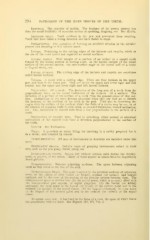Page 446 - My FlipBook
P. 446
294 PATHOLOGY OF THE HAED TISSUES OF THE TEETH.
Immobile. The opposite of mobile. The features of the person present less
than the usual flexibility of muscular motion in speaking, laughing, ete. See Mobile.
Impacted teeth. Teeth confined in the jaw and prevented from erupting.
Teeth that have taken a wrong direction and have failed to erupt.
Implantation. The operation of forming an artificial alveolus in the alveolar
process and inserting in it a natural tooth.
Incisal. Pertaining to the cutting edges of the incisors and cuspids, which in
the use of the word incisal are regarded as incisal surfaces.
Incisal margin. That margin of a surface of an incisor or a cuspid tooth
formed by the incisal surface or cutting edge; as the incisal margin of the labial
surface of the central incisor; the cavo-surface angle of the incisal wall of a labial
or lingual cavity, ete.
Incisal surface. The cutting edge of the incisors and cuspids are sometimes
called incisal surfaces.
Incisor. A tooth with a cutting edge. There are four incisors in the upper
jaw, and four in the lower jaw. They are called the upper and lower right and left
central, and the upper and lower right and left lateral incisors.
Inclination. Of a tooth : The deviation of the long axis of a tooth from the
perpendicular line: as the mesial inclination of the incisors. Of a surface: The
deviation of a portion of the surface of a tooth from the general plane of that sur-
face. Inclinations of the teeth become abnormal when they are such as to disturb
the harmony of the positions of the teeth in the arch. Used also in describing the
angles with the surface of the tooth at which the walls of a cavity may be cut, or of
the relation of opposing walls to each other, as outward inclination, inward inclination,
etc. Also, inclination of enamel rods from a line perpendicular to the surface of a
tooth.
Inclination of enamel rods. Used in describing either normal or abnormal
inclinations of the enamel rods from a direction perpendicular to the surface of
the tooth.
Incline. See Inclination.
Inlay. A porcelain or metal filling for inserting in a cavity prepared for it
in a tooth ; and retained by cement.
Instrumentation. All uses of instruments in dentistry are included under this
term.
Instrument geasps. Definite ways of grasping instruments suited to their
uses, such as the pen grasp, thrust grasp, etc.
Interglobular spaces. Spaces left without calcium salts during the develop-
ment, or growth, of the dentin. Many of these appear as spaces between imperfectly
fused globules.
Intep.proximal. Between adjoining surfaces. The space between adjoining
teeth as they stand in the line of the arch.
Interproximal Space. The space bounded by the proximal surfaces of adjoining
teeth, by the planes of their buccal (or labial), occlusal (or incisal), and lingual
surfaces, and by the crest of the septum of the alveolar process between them. The
interproximal space is divided into (1) the septal space, which is normally filled with
the interproximal gum septum, or septal gingivae; (2) the buccal (or labial)
embrasure, the open space to the buccal (or labial) of the contact point and to the
occlusal (or incisal) of the septal tissue; (3) the lingual embrasure, the open space
to the lingual of the contact point and to the occlusal (or incisal) of the septal
tissue.
Inverted cone bur. A bur head in the form of a cone, the apex of which forma
the attachment with its shaft. See Figures 170. 171, Vol. 2.


